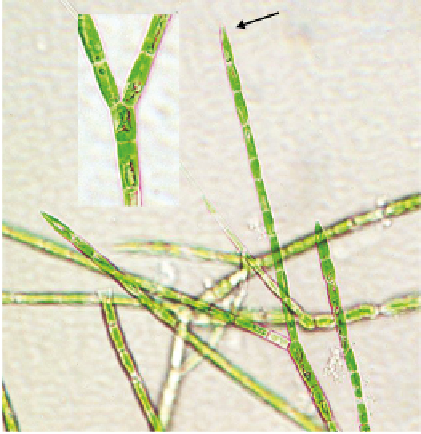Environmental Engineering Reference
In-Depth Information
(b) Mucilage covering thin. Usually
attached at base and forming trailing
branched filaments. Not cushion-like or
globular...................
Stigeoclonium
(see also key No. 17)
20
(19) (a) Cushions composed of filaments with
branches tapering to a long multicellular hair
or having a single rounded cell at apex.
Mucilage firm, forming cushions 1-2+ cm
wide.......................
Chaetophora
(see also key No. 16)
(b) Cushions generally smaller (
5mm
diameter). Filaments with less branches and
cells rounded or with swollen ends, often
lime encrusted. ...............
Gongrosira
>
50 μm
Figure 4.5
Stigeoclonium
. General view of filaments,
with branches tapering to a fine point (arrows). Inset:
Mode of branching.
Gongrosira
forms cushion-like colonies that
may be lime-encrusted in hard waters. Fila-
ments arise from a basal prostrate group of
cells, forming an erect as well as a pros-
trate system. No hairs present and termi-
nal cells of branches bluntly rounded. Cells
cylindrical or swollen, often with thickened
walls. Parietal chloroplasts with one to sev-
eral pyrenoids. Frequent in streams, shallow
lake margins or ponds, on stones, often in
hard water regions. Cells 4-30 μm wide, 1
to 3 times longer than wide. Chlorophyta.
Plate IV.
variety of surfaces. Branches can be oppo-
site, alternate but rarely whorled and termi-
nate in a tapering series of cells sometimes
forming a terminal multicellular hair. Fil-
aments surrounded by a thin mucilaginous
layer. Chloroplasts parietal with one or more
pyrenoids. Cells 5-40 μm wide, many times
longer than wide. Widespread distribution,
usually attached to rocks or stones but may
break away and can be found free-floating.
Severalspecies,inlowingorstillwaters.
Sti-
geoclonium tenue
is common and is often
used as an indicator of enriched or organ-
ically polluted situations (also reported as
tolerant to heavy metal pollution). Chloro-
phyta Plate III. Fig. 4.5.
21
(18) (a) Plants small, erect. Cells 1.5-5 μmdiam-
eter, up to ×12 as long as wide. Cell walls
thin. Filaments highly branched with the first
cross wall of a branch being a small dis-
tance from the main axis. Pyrenoids absent
........................
Microthamnion
18
(13) (a) Branched filaments embedded in
mucilage.............................
19
Microthamnion
consists of attached del-
icate branched filaments of the same
width throughout. Chloroplasts parietal and
pyrenoids absent. Widespread distribution,
often in acid organically rich waters and
waters with higher iron and/or manganese
compounds. Attached to substrate by means
(b) Branched filaments not embedded in
mucilage.............................
21
19
(18) (a) Plant forms a gelatinous globular cush-
ion. Mucilage may be firm and encrusted
withlimeinhardwaterlocations.......
20


Search WWH ::

Custom Search